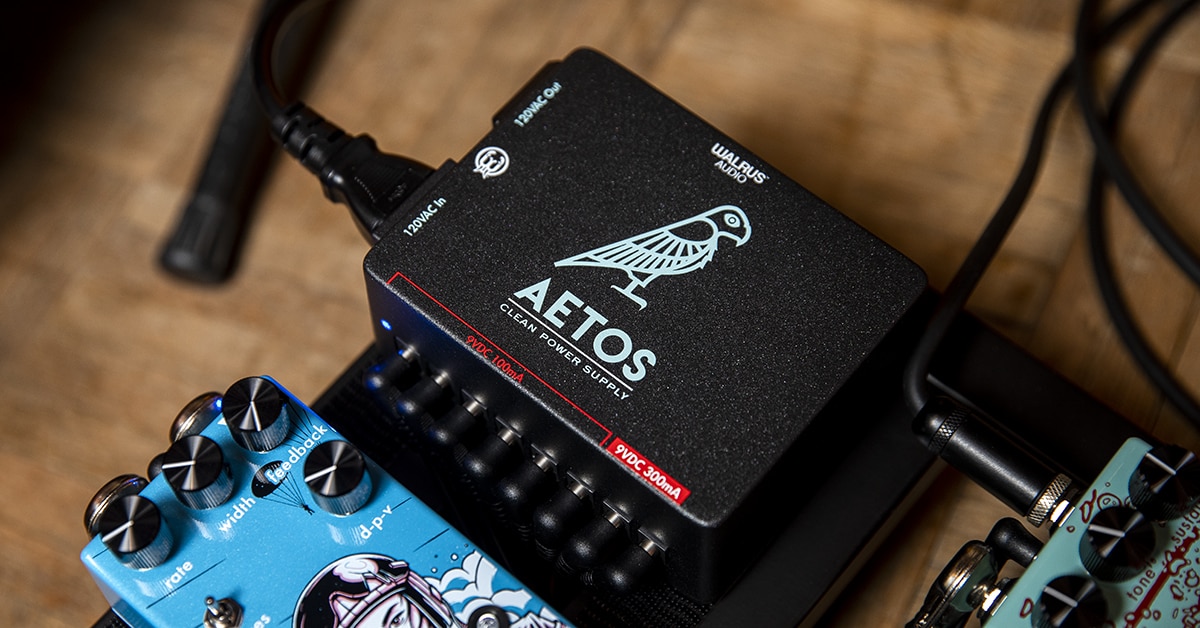Batteries—as musicians we have a love/hate relationship with them, especially when it comes to powering our effects pedals. That becomes even more so when our pedals are mounted on a pedalboard and dealing with a dead or dying battery becomes a major project. If you're running more than two or three pedals, you've probably started thinking about assembling your own pedalboard, and we're here to help you figure out the right way to keep it all powered and running smoothly.
In this article, we're going to go over how to power effects pedals. We'll look at the variety of pedalboard power supplies available, their pros and cons, and help you figure out the best pedal power supply for when you're ready to put your pedals to the metal. If you're starting totally from scratch, we also recommend that you check out our article on How to Build a Guitar Pedalboard for tips on choosing the physical pedalboard itself.
As usual with these articles, the first section is going to provide some background and a general overview. We recommend that you read it, especially if you're looking to put together your first pedalboard. If you've already got some basic knowledge and just want to get to the part where we talk about the individual products, just use the links in the handy Table of Contents (coming up next) to jump directly to those sections. We won't be offended.
Table of Contents
Why Do You Need a Power Supply for Your Pedal Board?
A Little Science to Cleanse Your Palate
Volts, Amps: What's the Difference?
Getting Centered With Polarity
Basic Types of Power Supply
Daisy Chain Power Supplies
Isolated Power Supplies
How to Pick the Best Power Supply for Your Pedal Board
Our Top Pedal Power Supplies
Truetone 1 SPOT Combo Pack
MXR M238 iso-brick
Voodoo Lab Pedal Power X4
Voodoo Lab Pedal Power 3 PLUS High Current
Ernie Ball Volt
Fender Engine Room LVL8 Power Supply
Mission Engineering USB Power Supply
CIOKS DC-7
Truetone 1 SPOT PRO CS12
Final Thoughts
Why Do You Need a Power Supply for Your Pedal Board?
Guitarists love pedals. It doesn't take long—maybe after your third pedal—to get tired of having to juggle them around to get set up, and you start thinking about a pedalboard, so they're always ready to go. But, once your pedals are mounted on a board, changing batteries becomes a huge pain. Add that to the fact that many modern pedals don't use batteries, either because of small form factors or because the Digital Signal Processing (DSP) chips used in those pedals need higher current than batteries can easily provide to get the job done. That's the time guitarists start looking around for a power supply that can handle all their pedals. With the wide assortment of pedalboard power supplies available, a little background info is necessary for you to make a decision that will work in the long run.
A Little Science to Cleanse Your Palate
Before we dive into an overview of the various types of power supply design, we should probably take a quick look at some basic concepts in electronics. Don't worry, there won't be any math involved, and there's no quiz afterward.
Volts, Amps: What's the Difference?
Every power supply you come across will be rated for two things: volts and amps. So, what are they, and how are they different? Let's start with the single most popular analogy in general science—a water faucet.
If you think of a source of electricity as a water faucet feeding a hose, voltage is analogous to the water pressure in the system. It's the amount of potential energy the system can supply. While traditionally, pedals used those pesky rectangular 9V cells, a fair number of pedals require 18V or 12V, and some newer pedals even use a 5V power supply, like a USB port.
Amperage can be thought of as the volume of water flowing past a certain point (which may be why amperage is also referred to as "current"). So, a higher amperage would be equivalent to a larger pipe which allows a greater volume of water flow at that constant pressure (voltage).
So, getting back to electricity, you can see that a pedal that needs 9V at 300mA (milliamps) won't work with a power supply rated at 100mA, simply because it can't supply enough current flow for the components in the pedal to fully turn on. Modern DSP-based pedals tend to need an available current of 250mA and higher, which would drain a regular battery pretty quickly.
Getting Centered With Polarity
Polarity is a property of DC (direct current) power supplies. As the name DC should imply, the current only flows directly from the positive to the negative terminal (electron flow goes from negative to positive, but that's a whole other thing). AC (alternating current) keeps switching negative and positive poles, but we're not going into that here. If a DC pedal has the supply polarity reversed, at absolute best, assuming that the circuit has reverse polarity protection, nothing will happen, and the pedal will simply not do anything. At worst (no protection circuit) you stand a chance of damaging the pedal, or, as electronics techs are fond of saying, "letting the magic smoke out."
You'll notice that most of the battery-powered pedals that can also be externally powered (which is almost all of them these days) are labeled with a little icon on the back indicating that it needs a DC power supply with the center pin carrying the negative voltage. You may have thought, "I've got a bunch of power supplies sitting around from old consumer electronics devices. I can use one of those," only to discover that they're almost all carrying the icon that indicates that the center pin is positive, and you can't use them. So, be forewarned that you want the volt/amp icon on the power supply to match the one on the pedal, or bad things might happen.
Basic Types of Power Supply
There are a couple of basic types of power supplies we'll look at, although the second class has two subdivisions.
Daisy Chain Power Supplies
The first, and most basic, is the daisy-chained power supply. These supplies tend to be the most affordable and supply a single voltage with chained connectors. As long as the total current demand of your combined pedals is less than the available current rating of the power supply, it's a simple and solid way to power a pedal collection.
While many users have no problems with daisy-chained power supplies, they are vulnerable to fostering ground loops, since the pedals are already sharing one common ground through the pedal's sleeve connectors and the interconnecting instrument cables. Since any noise or interference then has two potential paths to ground (audio path and power supply) any noise from a loop gets picked up and passed to all of your pedals, which are likely to re-amplify the noise. There are also some pedals that simply will not work with a daisy-chained power supply. Usually this is noted in their manuals, but some vintage pedals, like germanium fuzzes, just can't deal with being chained with center-negative powered pedals. If you only have a few, well-behaved pedals, a daisy-chain power supply can be your quickest, easiest and most affordable option to power your pedalboard.
Isolated Power Supplies
The second class of power supply are the ones that provide isolated power outputs. This means that each transformer-isolated output has its own ground and, potentially, voltage. This virtually removes the possibility of ground loops and associated noise. It also enables you to have outputs that are dedicated to devices with higher current needs. It can also have outputs with switchable voltage, usually from 9V to 12V, and adjustable voltages, which we'll talk about a little more in the next section.
Linear Mode Power Supplies
Within the class of isolated power supplies there are two different types—linear regulated and switched mode. Linear power regulation is a very traditional analog design. The linear regulator acts like a variable resistor, making sure that only the needed power is allowed through. This makes for very low-noise, ripple-free power, but comes at the cost of being inefficient. Whatever voltage is above what's needed, gets burned off as heat, so linearly regulated supplies tend to be larger and heavier, due to the need for large heat-sinks to dissipate that excess thermal energy. It also means that you might end up using up to twice as much power as you need to get the job done.
Linear mode supplies are not graceful at handling multiple AC power sources, so generally they will either be for 120V 60Hz AC or 220V 50Hz AC only. The ones that can switch between source voltages tend to be a little larger, due to the need for a different type of transformer. They also have to be manually configured for different main voltage levels. Forgetting to switch when needed can make for informal pyrotechnic effects, the type you distinctly do not want.
Switched-Mode Power Supplies
Switched-mode power supplies are more efficient than linear regulation. In the simplest possible terms, these use a semiconductor to rapidly switch between on and off modes, then inductors and capacitors to smooth out the ripples in the power. They generate minimal heat and are much smaller and lighter than linear-regulated supplies while having the capacity to supply higher current levels. In fact, most of the "wall-wart" power supplies you encounter these days are switched mode. The biggest downside of switched-mode supplies is that they can have a higher noise floor, hence less dynamic range, than linear-mode, requiring more filtering. But that's only a "can." Our recommendations here are consistently quiet.
Note that whether a power supply is linear regulated or switched mode is not necessarily obvious. The general rule of thumb is if it can handle 120/220 without having to flip a switch on the supply, it's a switched-mode one.
How to Pick the Best Power Supply for Your Pedal Board
So, what's going to be your best choice for a pedalboard power supply? Here are a few of the things you should consider, beyond just how many pedals you want to power and how big your pedalboard is.
- What is your mix of pedals? Are they all analog? All digital? Or do you have a mix of both? Digital pedals are going to draw a lot more current, typically at least 250mA to as much as 500mA each. So, you'll need to look for a power supply with individual outputs capable of supplying that much current on each output with a digital pedal connected to it. Fully analog pedals usually need 100mA or less.
- Do all your pedals run at the same voltage? While most pedals want to see 9V, there are a number that require 12, 18 or 24 volts. So, if you own any of those, you'll need to make sure that the power supply you choose has a way to power them, which can be either a dedicated output or a specific type of "Y" cable that connects two outputs in series, thereby doubling the available voltage.
- Do all your pedals have the same polarity? We touched on the pervasiveness of center-negative power sources in the section above, but some more modern pedals, especially those that don't take batteries, run center-positive jacks. If you have some of those, you'll either need outputs that can be switched between the two or, a more common solution, power supply cables that make the switch. Pro tip: Although most manufacturers use some sort of color-coding system for those cables, it's a good idea to use your own colored tape or something that's easy to see when you're swapping a power supply cable out, on stage, in the dark.
- Do you have some pedals that change behavior when voltage is cut? Many drive and fuzz pedals without an internal power regulation circuit can get sputtery and spiky in a kind of cool way as the battery dies and voltage drops. Essentially, what's happening is the available input gain reduces as the power drops and as the voltage gets close to the point where the internal transistors are about to stop working altogether, and the signal starts cutting in and out in an interesting, musically useful way. If you like that sound, and have a pedal that does it, you'll want a power supply that has an output or two with a "Sag" control. Some newer versions of these pedals have a 'sag" feature built in, so check the manual that you stashed in the closet to be sure your pedal doesn't already have this feature. Power supply outputs with variable voltage controls have a small trimpot that can be used to drop the output voltage to simulate a dying battery. Note that this will not work on pedals that have an internal voltage regulator.
Now that we've talked a little about the things you'll have to think about in choosing a pedalboard power supply, let's dive in and take a look at our picks for some of the best pedal power supplies on the market today.
Our Top Pedal Power Supplies
Truetone 1 SPOT Combo Pack
We really have only one recommendation for daisy chain power supplies. Truetone's 1 SPOT power supply has pretty much dominated the world of daisy chain power supplies since it first came to market over 20 years ago. Using a quiet, well-filtered switching 9V wall-wart-style power supply, it delivers up to 1700mA of power at 9VDC. That's enough to run 200 low-current overdrive pedals like the classic Ibanez TS808 Tube Screamer with power to spare. The basic 1 SPOT Combo Pack comes with an eight-pedal daisy-chain cable and multiple converters to power pedals that only have a battery connection or a specialty connector.
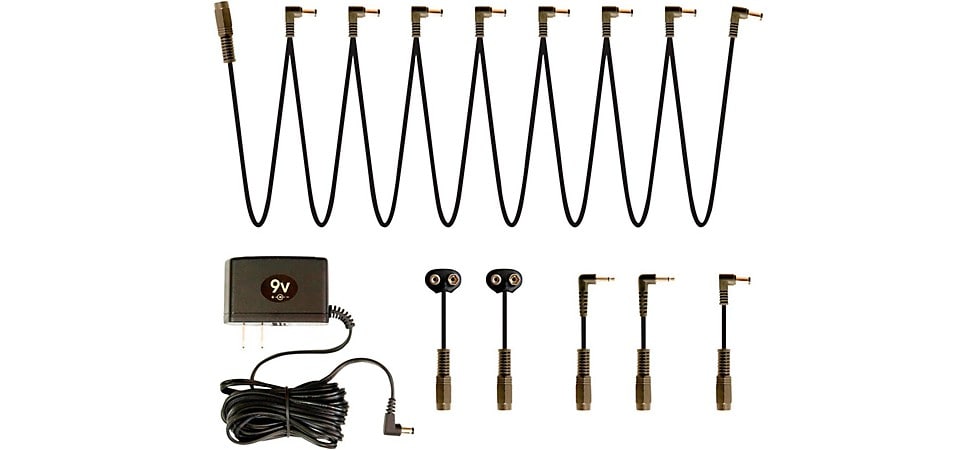
Pictured: Truetone 1 SPOT Combo Pack
For many players, the Truetone 1 SPOT Combo Pack may be all you need, especially if your pedals all take 9VDC and are relatively modern. While many digital pedals work fine with the 1 SPOT, there are some that are noisy when daisy-chained, so this may not be the right power supply for day-to-day use for those pedals. However, the Truetone 1 SPOT is so affordable, that we think having one just as an emergency backup (because you never know what's going to happen on a gig), is something every guitarist with a pedalboard should consider.
MXR M238 iso-brick
MXR has been building pedals for 50 years, so it's no surprise that they should produce a solid power supply. The M238 iso-brick runs from an international-friendly external 18V wall-wart transformer and is one of the smallest and most lightweight isolated output supplies in this list. All outputs are fully regulated and provide clean, quiet power. The M238 offers six 9V outputs—two each at 100, 300 and 450mA—a pair of 18V, 250mA outputs and two adjustable outputs. The adjustable outputs can vary from 6V to 15V at 250mA. That gives you an option for a 12V pedal or to turn one into a "sag" supply that emulates a dying battery for the non-buffered, non-regulated drive and fuzz pedals we discussed above. Pro Tip: Get a small voltmeter or multimeter to check the voltage on these outputs when you're dialing them in. It's great if it fits in your gig bag, too, to check voltages on the gig, though we don't recommend checking the wall power with one of those. Leave that to somebody who's used to playing with high AC voltages. The M238 also has helpful status LEDs for each output and built-in protection against overloads and shorts.
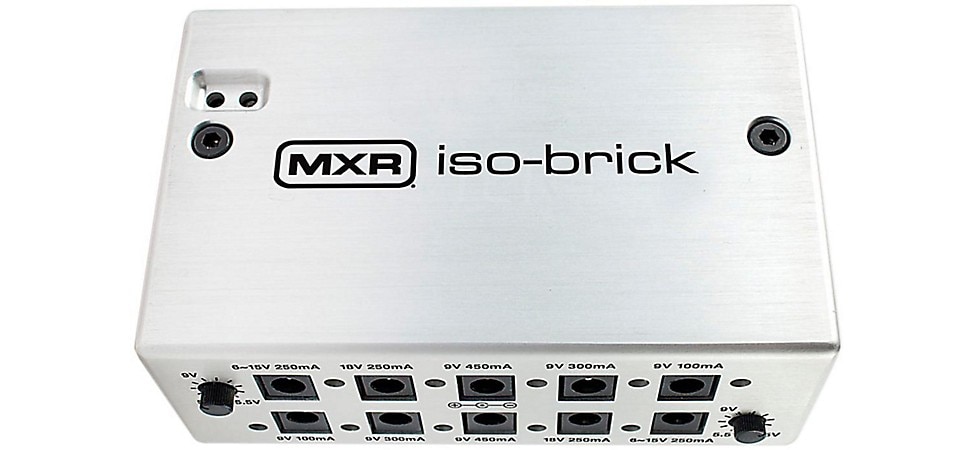
Pictured: MXR M238 iso-brick
Voodoo Lab Pedal Power X4
Voodoo Lab is another company that's been around for several decades, and their Pedal Power series was one of the first fully isolated power supplies. The US-made Pedal Power X4 is the first of two Voodoo Lab products on our list. If you need ultra-clean, isolated power for up to four 9V pedals, this linear regulated supply will supply a total of 1,000mA, with a maximum of 500mA to any one output, making it a great choice if you run multiple current-hungry digital pedals. The provided wall transformer is fine with international voltage variations and the X4 even comes with 3M Dual-Lok tape for mounting. The extremely small size of the supply makes it easy to mount on any size pedalboard. One feature that's handy is the ability to connect the X4 to other Voodoo Lab Pedal Power supplies for easy expansion, which brings us to our next candidate.
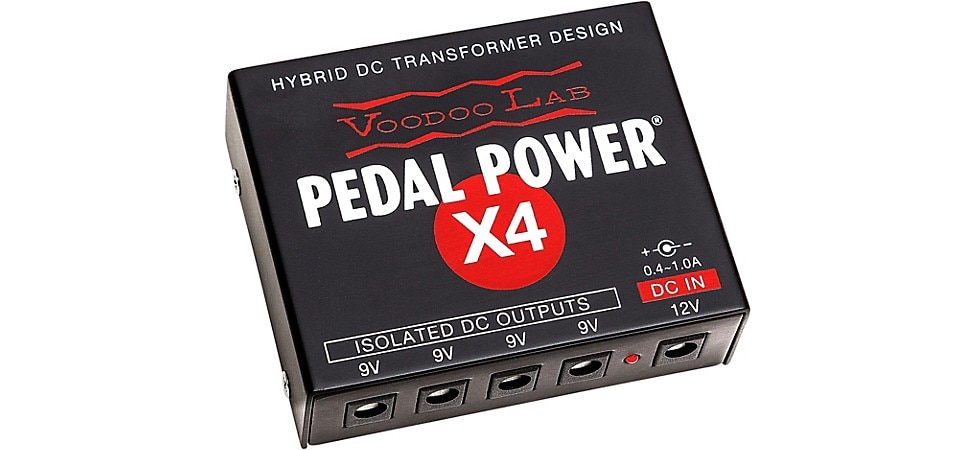
Pictured: Voodoo Lab Pedal Power X4
Voodoo Lab Pedal Power 3 PLUS High Current
The Voodoo Lab Pedal Power 3 PLUS has a lot to bring to the table here. Using linear power regulation and a system of computer-optimized noise filtering, it is incredibly quiet. It provides 12 fully isolated outputs, ten of which provide a whopping 500mA each. The final two are switchable between 9V/200mA and 12V/500mA. The power feed to the Pedal Power 3 PLUS uses a standard IEC power cable and accepts 100V to 240V for easy international travel. It comes with an assortment of DC power cables that should cover most everything you need. The 3 PLUS design also allows for 18V and 24V pedals as well, with the optional voltage doubler cable. As we alluded to in the Pedal Power X4 section, the Pedal Power 3 PLUS has two expansion ports, called X-LINK, that will connect to Voodoo Lab X4 or X8 modules to add up too 16 additional isolated power outputs. That's a lot of pedals.
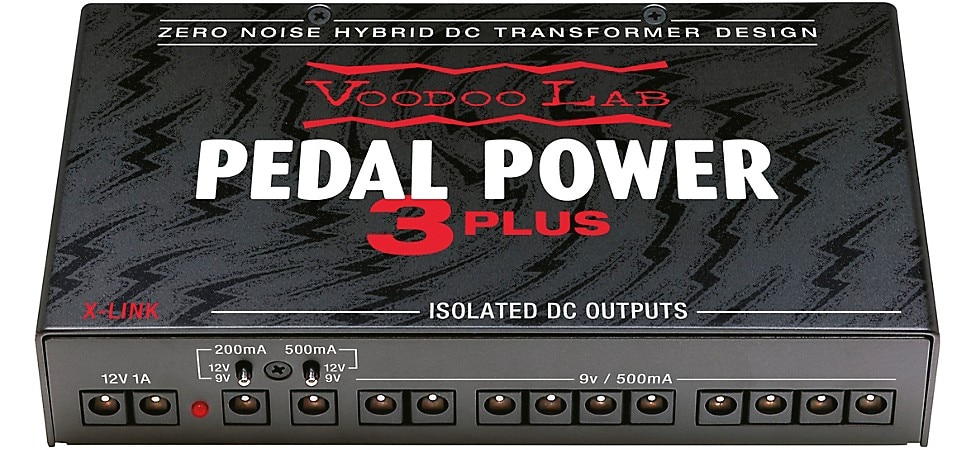
Pictured: Voodoo Lab Pedal Power 3 PLUS High Current
Ernie Ball Volt
One of the smallest isolated power supplies on our list, the Ernie Ball Volt uses a combination of linear and switched-mode regulation to deliver ultra-low-noise 9V and 18VDC power. The tiny box gets its power from a switched-mode 18V wall wart and has four 9V/300mA and one 18V output that's essentially a passthrough from the wall supply. This 18V output can be used to daisy chain other Volt units if it's not being used for a pedal, so the system can easily be expanded. All inputs and outputs have LED status indicators and are protected against potential short circuits. The unit is also thermally protected. The high-current rating on the 9V outs makes this a great choice for boards that are running a few DSP-based digital pedals, and its expandability gives you room to upsize your pedalboard as needed.
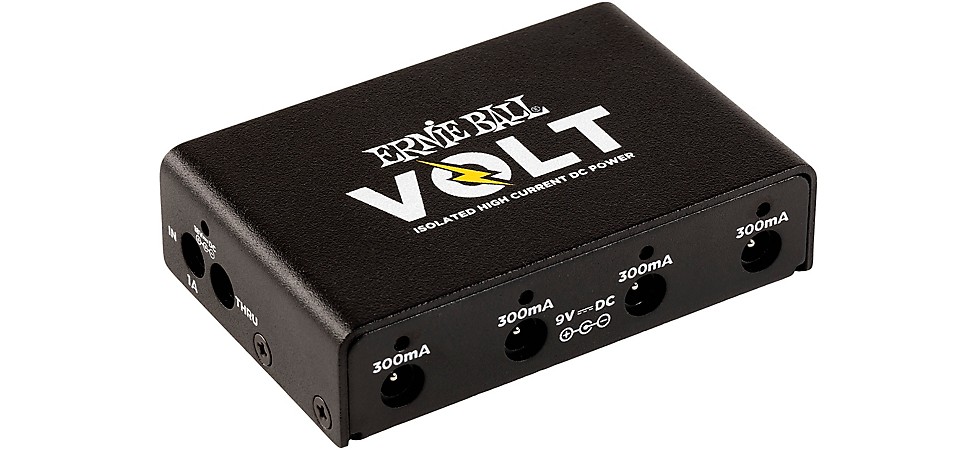
Pictured: Ernie Ball Volt
Fender Engine Room LVL8 Power Supply
As Fender has expanded their own selection of pedals, they've also developed the Engine Room series of linear-regulated isolated power supplies. The Fender Engine Room LVL8's eight outputs are all rated at 500mA at 9V, and two of them are switchable to 12 or 18V. A nice addition here are the pair of USB charging ports, one USB-A and one USB-C. This last feature is especially handy if you're one of those musicians who uses their phone or tablet onstage, or have been considering it. Bi-color LED indicators show the status of each output port. Fender provides eight standard 2.1 mm to 2.1 mm barrel connector cables in varying lengths, which is convenient for medium and large pedalboards where you may need a longer stretch. They also include some special purpose cables, appropriately color coded. Conveniently, if you upsize your pedalboard, it can be daisy-chained to the larger LVL12, for a much larger capacity. The LVL8 is 120V only, so if you end up doing an international tour, you'll need a second supply or a step-down transformer.
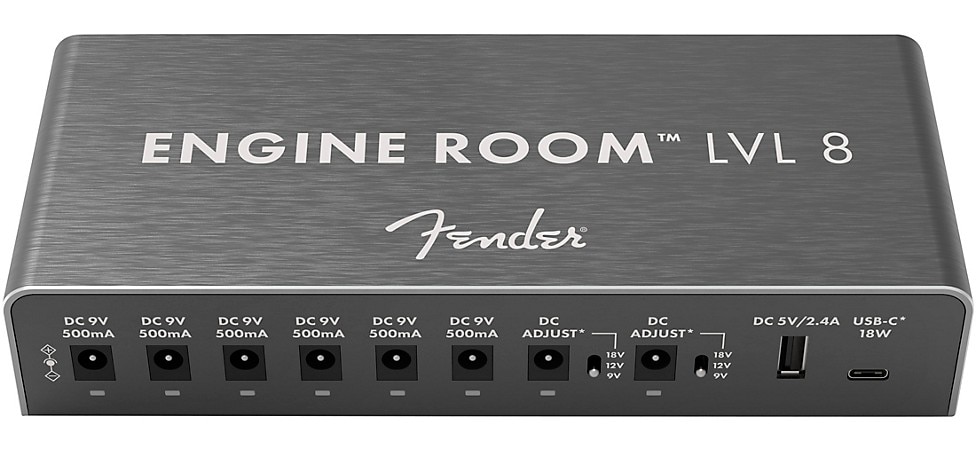
Pictured: Fender Engine Room LVL8 Power Supply
Mission Engineering USB Power Supply
The compact, lightweight Mission Engineering 529 USB Power Supply is a very interesting variation. Powered by a 5V wall wart, like you might use to charge a mobile device, it can also run from an approved USB power bank, which makes it seriously convenient for players who don't necessarily want a separate AC or other power cable running to their pedalboard. The supply itself has five 9V outputs, four rated at 125mA and one, intended for high-current digital pedals, rated at 500mA. The 529 can also be daisy-chained for easy expansion and is exceptionally quiet. The ability to run your pedals from a battery, as well as directly from the wall, makes this one a unique choice, especially for those who try and keep audio and power as far apart has possible.
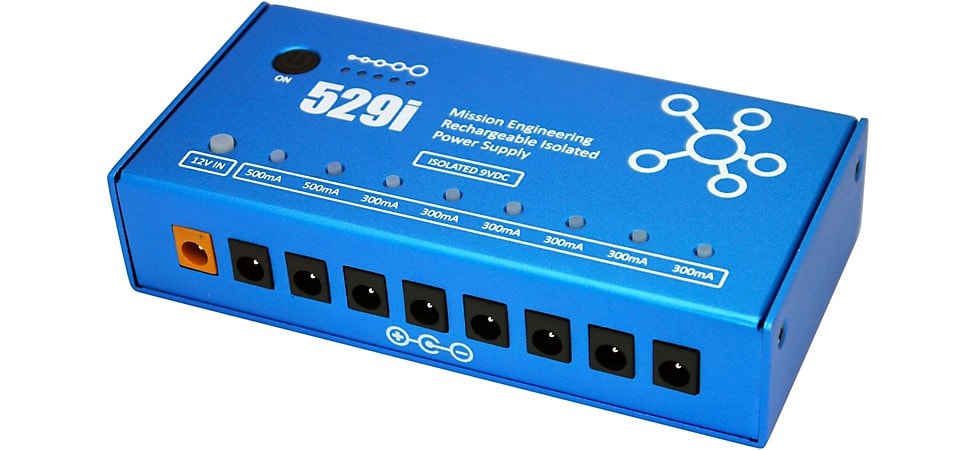
Pictured: Mission Engineering USB Power Supply
CIOKS DC-7
Over the past few years, the Denmark-based CIOKS (pronounced "chocks" if you're curious—it's the last name of the founder) has been raising their profile as a source for solid, well-built and quiet switched-mode power supplies. The CIOKS DC-7 offers seriously high-current capacity, with each of the seven outputs capable of providing a whopping 660mA at 9V. Each output is also configurable to 12V, 15V or 18V via DIP switches. It also has both a 5VDC USB output and a 24V output and allows daisy-chaining with any 24V power supply (not just CIOKS), for easy expansion. The CIOKS DC-7 comes with 12 cables, seven of which are center-negative, and the other five in variations (center-positive, 9V battery snap, etc.) for specific applications. A unique feature of CIOKS supplies is that, rather than use two standard 2.1 mm barrel connectors, the end that connects to the supply uses a sturdier, 5.5 mm phono ("RCA") connector. If you run a lot of high-current digital pedals, the DC-7 is a choice that should be at the top of your list.
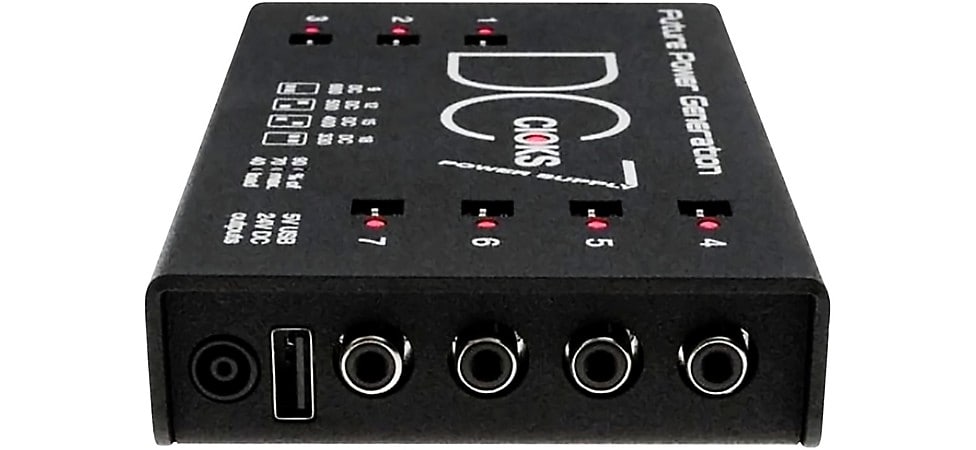
Pictured: CIOKS DC-7
Truetone 1 SPOT PRO CS12
We started this list with the Truetone 1 SPOT daisy-chain supply, and we're ending it with another Truetone—the 1 SPOT PRO CS12. Far and beyond the simple daisy-chain, this is a 12 output, lightweight, switched-mode power supply that it intended for large boards. The 1 SPOT PRO CS12 has two 9VDC/250mA, two 9VDC/500mA, four switchable 9/12VDC/100mA and two 18VDC/100mA outputs. It also has one "sag" output that is adjustable from 4VDC to 9VDC. You may be wondering why I'm specifying "DC" here, as I haven't for the other pedals. That's because the CS12 also has a 9VAC output that can power, for example, the Line 6 and DigiTech pedals that need high-current (up to 800mA) AC power, meaning you can finally ditch that giant wall wart that's been weighing down your system. Truetone supplies plenty of cables with the 1 SPOT CS12, so it's easy to get going, even if your pedalboard verges on Guinness Book size.
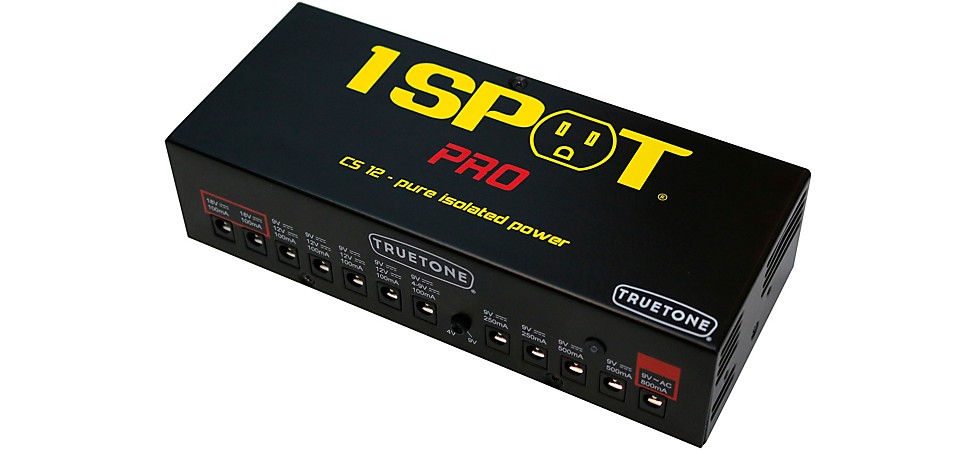
Pictured: Truetone 1 SPOT PRO CS12
Final Thoughts
Now that you've looked through this assortment of power supplies and considered just what would be a great match for your current (or planned) pedalboard, we're going to ask you to think just a little bit more. Looking down the road just a little bit, how do you see your pedalboard growing? Will you need more than one pedalboard in the long run? We know a bunch of players who keep two or three different-sized boards around for different types of shows. Plus, building a collection of cool pedals is one of the great pleasures of playing, and you need a place to put them. Consider not just where you are, but where you're planning on going.
You'll also want to make sure you have spares for things that break. Stock up on power cables for your pedals, patch cables, Velcro or 3M Dual-Lock for mounting pedals and power supplies, a spare IEC power cable or two (having gotten to a gig and discovering that the only one I had in the gig bag was bad, this is the voice of experience speaking), zip ties, quality extension cords and anything else that might kill a gig or rehearsal if the one you have breaks. A great choice to figure out what you may need is to talk with the experienced associates at your local Guitar Center store or at our call center. These folks have pretty much seen it all over the years and may think of some spares that you hadn't considered. We're sure that you'll end up with the pedalboard of your dreams that can expand with your needs.




